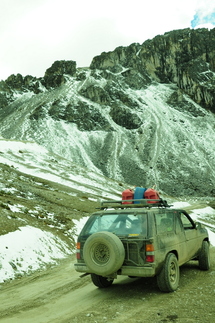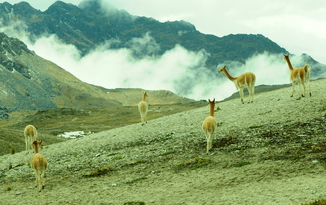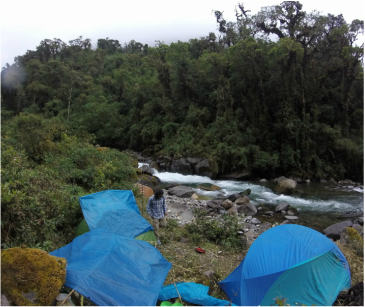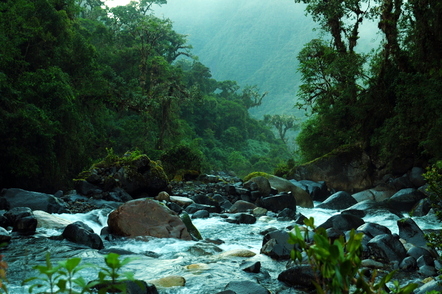



 Two weeks ago Alex Ttito and I embarked on a week long trip in search of missing and new frog species in the Peruvian Andes. This project is a collaboration with the Asociación para la Conservación de la Cuenca Amazónica supported by funds from the Mohammed bin Zayed Species Conservation Fund. We headed to a remote Andean community that recently created a private conservation area, a legally recognized area that protects biodiversity. These private conservation areas, along with conservation concessions, have been springing up in many regions of Peru, and are contributing to conserving biodiversity, especially amphibian biodiversity that has been somewhat neglected when the emphasis was on creating large protected areas. Our ride took us through some of the most spectacular landscapes of the Andes, near glaciers and high-Andean lakes and wetlands. In the photo, good old Shigella (the 4-wheel drive Nissan) is braving a mountain pass near 5000 m partially covered by snow.  We stopped along the way to take pictures of some (illegal) gold mining operations not far from the mountain pass, and risked to lose our cameras and more when a car suddenly stopped along the highway and four angry miners started gathering rocks and asking us about our photographic interests. Perhaps unconvincingly, I explained I was taking pictures of the river and glacier behind, while restarting the car (thankfully Shigella promptly responded with a -for once- much welcomed puff of exhaust and gases -muffler needs some patching...). We left trouble and the paved road behind, and for another four hours rode in the midst of grasslands, glaciers and lakes, llamas, alpacas and even vicunas (see picture). It quickly became obvious that the effort in reaching the community would be very much worth the experience. The entire community was there to welcome us, and we had a communal meal while discussing the details of the hike to the conservation area with our guides. The following day we left the community, glaciers still in sight, and headed down towards the cloud forest. The landscape gently turned from rocky grasslands to shrubland interspersed with patches of cloud forest and old landslides. The weather started to become much more variable as we entered the area where clouds were rising from the bottom of the valley and delivering moisture to trees and epiphytes growing on the slopes of the valley.  We spent five days in the valley, trying to reach the lowest possible elevation, and finally managed to get down to ~2600 m by stepping from boulder to boulder along the river. The initial goal was to find species that have been missing from other valleys, such as harlequin frogs, but we were also expecting to find some new species, given the remoteness of the valley. We camped on the beach, and split up into frogging and fishing teams -our guides went fishing (trout abounds in the main river), while we started flipping rocks and searching the leaf litter for the secretive, and often silent frogs that inhabit these cloud forests. Unfortunately we did not have much luck finding missing species, mostly because we couldn't reach lower elevations, but we did find several new species, on average about one every day! These species belong to groups of highly endemic frogs, and it is now becoming clear that each valley in the eastern slopes of the Andes, if large enough and separated by high ridges from adjacent valleys, supports its own set of unique species. I was playing around with a small portable camera (which did not survive the trip), and caught the very moment a new species was found, after flipping a large rock! Here's the video that shows the beautifully patterned new species:  By the fourth day, and despite all the trouts and potatoes our guides generously provided to supplement our limited food supplies, we started getting hungry. The first cold front of the season (austral winter) made its way from the lowlands and up the valley, and we spent a couple of very cold nights, with temperatures nearing freezing the last night. It was time to head back to the community. We decided to just hike back in just one long bout, and covered 1000 m in elevation in about 6 hours, with some stops to search the leaf litter along the trail. We did not find any more new frogs, but for some lengths it seemed we were walking just behind a large puma and her cub.
0 Comments
Leave a Reply. |
Archives
June 2024
CATENAZZI LABNews from the lab Categories |